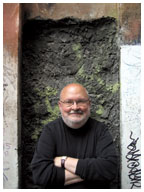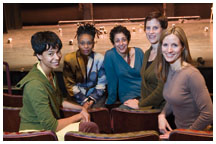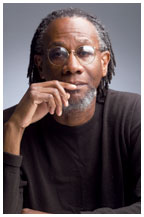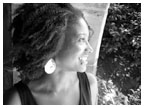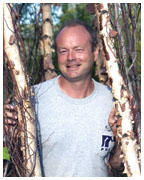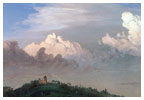January 24, 2007: Books and Arts
Reading Room
A year in Rome
Leonard Barkan blends travelogue and criticism in memoir
For a complete list of books received, click here.
In his new book, Leonard Barkan explores Italian food, wine, art, and love. (Farrar, Straus and Giroux) |
A
year in Rome
Leonard Barkan blends travelogue and criticism in memoir
By Jane Carr ’00
After returning from a year spent living and working in Rome, comparative literature professor Leonard Barkan was invited to give a lecture at the New York Public Library. Barkan had prepared a cerebral presentation, but a friend urged him instead to speak more personally. He did, sharing with an appreciative audience evocative descriptions of Italian art and culture and his experience with unrequited desire. Thus, Satyr Square: A Year, A Life in Rome, was born. The book’s subtitle captures Barkan’s feeling that one year in Rome might change him “for a whole lifetime.”
 In
Satyr Square, published in October by Farrar, Straus and Giroux,
Barkan blends memoir and travelogue with a sharp critical acumen and beautiful
and witty prose. On the surface, the premise of Satyr Square seems deceptively
simple: A professor chronicles the year he spent in Rome researching the
Roman Renaissance custom of unearthing and recycling ancient sculpture.
This work became the subject of Barkan’s book Unearthing the
Past (2001); in Satyr Square, he offers not just an account
of his research but an excavation of what friend and critic Richard Howard
calls “the archaeology of the modern self.”
In
Satyr Square, published in October by Farrar, Straus and Giroux,
Barkan blends memoir and travelogue with a sharp critical acumen and beautiful
and witty prose. On the surface, the premise of Satyr Square seems deceptively
simple: A professor chronicles the year he spent in Rome researching the
Roman Renaissance custom of unearthing and recycling ancient sculpture.
This work became the subject of Barkan’s book Unearthing the
Past (2001); in Satyr Square, he offers not just an account
of his research but an excavation of what friend and critic Richard Howard
calls “the archaeology of the modern self.”
Lonely and isolated at first, Barkan soon finds friends and compatriots among local foodies and wine lovers, while the prospect of romantic love remains tantalizingly elusive. He walks the city of Rome, each day taking another pathway that may lead him to the Pantheon or the Vatican. His time spent in Roman churches causes him to question his identity as a Jewish boy from Greenwich Village. Meanwhile, the vague flirtations of attractive, intelligent Italian men confound Barkan’s desire to find love as a gay man.
For all its lush description, Satyr Square offers at its core a sensual meditation on art in its myriad forms — poetry, sculpture, painting, opera, and culinary prowess. His artful knowledge and consumption of wine earns Barkan an invitation to join a local wine shop’s private tasting group. These locals and expatriates become his comrades, including a charismatic Italian man whose friendship with Barkan is the book’s defining relationship.
The Arthur W. Marks ’19 Professor of Comparative Literature, Barkan continues to carry with him the experience of living in Italy. He writes frequently about wine and its relation to culture, and serves as a columnist for the English-language version of the Italian food and wine magazine Gambero Rosso. He also is working on a new book, about Michelangelo’s use of text in his drawings and his use of images in his poems, and will teach a course on the subject in the art history department this spring.
After reading Satyr Square, one is left with the impression
of Barkan as a citizen of the world of pleasure, a man who embraces the
advice of the friend who first urged him to describe the personal dimensions
of his life in Italy by declaring, “We all have interesting stories
to tell about our lives.” ![]()
Jane Carr ’00 is a writer and graduate student in Charlottesville, Va.
For a complete list of books received, click here.
 I Wish I’d Been There: Twenty Historians Bring to Life Dramatic
Events That Changed America — edited by Byron Hollinshead
’51 (Doubleday). Hollinshead asked 20 historians what scene or incident
in American history they would like to have witnessed and why. Through
personal narratives, the historians recreate those incidents, including
the Salem witchcraft trials and the 1963 March on Washington led by Martin
Luther King Jr. Hollinshead is a former president of Oxford University
Press.
I Wish I’d Been There: Twenty Historians Bring to Life Dramatic
Events That Changed America — edited by Byron Hollinshead
’51 (Doubleday). Hollinshead asked 20 historians what scene or incident
in American history they would like to have witnessed and why. Through
personal narratives, the historians recreate those incidents, including
the Salem witchcraft trials and the 1963 March on Washington led by Martin
Luther King Jr. Hollinshead is a former president of Oxford University
Press.
 Professors’ Guide to Getting Good Grades in College —
Lynn F. Jacobs ’77 and Jeremy S. Hyman *79 (Collins). The authors,
who are married, share the inside scoop on how professors evaluate papers
and exams, and offer advice for students who want to earn higher grades,
including how to study for tests, how to write effective papers, and how
to treat the professor like an ally. Jacobs is an associate professor
of art history at the University of Arkansas. Hyman has taught philosophy
at several universities.
Professors’ Guide to Getting Good Grades in College —
Lynn F. Jacobs ’77 and Jeremy S. Hyman *79 (Collins). The authors,
who are married, share the inside scoop on how professors evaluate papers
and exams, and offer advice for students who want to earn higher grades,
including how to study for tests, how to write effective papers, and how
to treat the professor like an ally. Jacobs is an associate professor
of art history at the University of Arkansas. Hyman has taught philosophy
at several universities.
 Smart Women and Small Business: How to Make the Leap from Corporate Careers
to the Right Small Enterprise — Ginny Wilmerding ’91
(John Wiley & Sons). Targeted for midcareer women who have experience
working for corporations but want to go out on their own, this book offers
advice to find the right entrepreneurial fit, be it joining, buying, or
consulting for existing small businesses or starting a new company. Wilmerding
is a small-business consultant and former small-business owner.
Smart Women and Small Business: How to Make the Leap from Corporate Careers
to the Right Small Enterprise — Ginny Wilmerding ’91
(John Wiley & Sons). Targeted for midcareer women who have experience
working for corporations but want to go out on their own, this book offers
advice to find the right entrepreneurial fit, be it joining, buying, or
consulting for existing small businesses or starting a new company. Wilmerding
is a small-business consultant and former small-business owner. ![]()
By K.F.G.
Leaded Favrile glass; 37.125 x 96.25 in. (94.3 x 244.5 cm); The Charles Hosmer Morse Museum of American Art, Winter Park, FlA. ) (8. Louis Comfort Tiffany (1848–1933); Tiffany Studios (1902–1918); Wisteria panel, from a frieze for dining room at Laurelton Hall, ca. 1910–20. |
Artist Louis Comfort Tiffany’s estate in Oyster Bay, N.Y., was
filled with the blown-glass and leaded-glass windows he created, including
the panel of a wisteria frieze from the dining room pictured above. That
work is part of the exhibit “Louis Comfort Tiffany and Laurelton
Hall: An Artist’s Country Estate,” curated by Alice Cooney
Frelinghuysen ’76, the Anthony W. and Lulu C. Wang Curator of American
Decorative Arts at the Metropolitan Museum of Art. The opening of the
exhibit in late November coincided with the publication of Frelinghuysen’s
book by the same name. The book, published by Yale University Press, and
the exhibit explore Tiffany’s former estate, Laurelton Hall, which
burned down in 1957. The son of the founder of Tiffany & Co., Tiffany
(1848–1933) filled Laurelton Hall with his glasswork, including
lamps, vases, and pottery, as well as objects from his collection of Islamic,
Asian, and Native American art. The exhibit includes pieces saved after
the fire, including an elaborate terrace, marble columns and all, and
breakfast furniture Tiffany designed. It runs through May 2. ![]()
Exploring
beauty, murder, and memory through dance
Faculty choreographers show off new works at concert
Choreographer and dancer Dyane Harvey, left, and actress Kelechi Ezie ’08 tell the story of a woman, Sechita, based on an excerpt from a poem by Ntozake Shange. (Ricardo Barros)
Theater and dance faculty members whose work was performed at a concert at the Roger Berlind Theater: from left, Edisa Weeks, Dyane Harvey, Ze’eva Cohen, Rebecca Lazier, and Meghan Durham. (Ricardo Barros) |
In the 1930s choreographer George Balanchine created his now-famous ballet Serenade to the music of Tchaikovsky’s Serenade for Strings in C Major. The dancers in Balanchine’s work wore graceful tulle skirts and embodied a classical idea of beauty — long, clean lines and precise movements. Rebecca Lazier, a modern dancer and choreographer and associate head of Princeton’s dance program, has reinterpreted Tchaikovsky’s score in a new work by the same name, expressing another vision of beauty in which bodies sometimes collide and crash to the ground.
Lazier’s Brooklyn-based dance company, Terrain, performed it at the faculty dance concert on Dec. 8 and 9 at the Roger S. Berlind Theatre in the McCarter Theatre Center. The concert included an eclectic assortment of new works by theater and dance faculty ranging in theme from infanticide to memory.
In addition to Lazier’s Serenade, the evening featured Ze’eva Cohen’s Meditation on a Square, inspired by her recent trip to Barcelona, where she observed people dancing a spirited folk dance in the town’s square. Meghan Durham’s company, Philadelphia-based Merge, performed Fragment of (Me)mory, an abstract work that explores memory as a part of identity as three dancers alternately peer into floor lights and move away from the light. In Sechita ... Revisited Dyane Harvey embodied one character, Sechita, based on an excerpt from Ntozake Shange’s poem For Colored Girls Who Have Considered Suicide When the Rainbow Is Enuf. Edisa Weeks and her New York City-based company Delirious performed She Loves Me, which addresses the painful psychology of infanticide. Weeks, portraying a mother who seems to kill her baby, dramatized the anguish and motives that might lead one to commit such an act.
Every few years faculty and their company dancers perform new works at Princeton so their students can witness “the depth and expertise of their teachers,” said Cohen, who founded the program in 1969 and remains its director. About 60 students take part in the dance program each semester.
Harvey, who has choreographed for theater, dance, and television, said that through Sechita ... Revisited, she aimed to “breathe [new] life into” Shange’s poem, which was first published in 1975 and has been widely performed on stage. The poem explored what it means to be a black woman in the 20th century. As Kelechi Ezie ’08 narrated and acted out the story of Sechita, a poor black performer living in the South, Harvey portrayed the character through dance.
Harvey has helped broaden the scope of the dance program by introducing a multicultural approach through her course, “The American Dance Experience and Africanist Dance Practices.” Her students learn seven principles of movement associated with African dance and how African-American choreographers and dancers have influenced American dance and culture.
Cohen’s work at the concert also reflected a multicultural approach to dance. Meditation on a Square, performed by the Pittsburgh-based company Bodiography Contemporary Ballet, represents the cultural interweaving of Christian, Moorish, and Jewish traditions in Spain’s folk dance, music, and architecture. Cohen’s dancers began and ended as if they were in a square, performing folk dances while the audience heard the recorded sounds from a crowd and church bells. Male dancers bounced a basketball, weaving in and out of the women’s circle, sometimes joining in the folk dance and sometimes watching.
In Lazier’s Serenade, the dancers, in loose-fitting clothing, acted as if they were rehearsing to a scratchy record of Tchaikovsky’s Serenade. Lazier, who is known for the raw physicality of her works, wanted to convey a “falling away from the music.” After the rehearsal section, the dancers took a break, drank water, and Lazier jumped on stage, as if she were the choreographer giving her dancers pointers before they put on the real show. One female and one male dancer performed a duet that examined the tension between being a couple and retaining their individuality.
In the final section the women, in old, faded pink dresses, and men
looked intentionally awkward at times, stumbling and falling to the music,
as if struggling against it. “I find falling and awkwardness very
beautiful,” said Lazier. At the end the dancers walked toward the
front of the stage facing the audience. They closed their eyes, listening
to the music. As it built in energy, they began dancing vigorously. As
the curtain descended, one dancer who was in front of the curtain dove
underneath to join the other dancing feet. ![]()
By K.F.G.
Nathaniel Mackey ’69
Tracy K. Smith
Kevin Wilkes ’83 (Photos courtesy Nathaniel Mackey ’69, Tina Chang, Cie Stroud) |
Nathaniel Mackey ’69, a professor of literature at the University of California, Santa Cruz, received the 2006 National Book Award for poetry for Splay Anthem (New Directions) on Nov. 15 in New York City. A poet, literary critic, and fiction writer, Mackey has written nine books of poetry. Splay Anthem, which forms the next installment of two ongoing serial poems Mackey has been writing for over 20 years, was called “mysterious, even hermetic” by Publishers Weekly.
Princeton assistant professor of creative writing Tracy K. Smith received the James Laughlin Award, a $5,000 prize that supports a poet’s second book, for her forthcoming Duende, to be published by Graywolf Press in June 2007. According to the Academy of American Poets, which presented the award Nov. 8 in New York City, Smith’s work is known for its “lyrical beauty and its look outside the self.”
Architect Kevin Wilkes ’83’s innovative
garden project on a lot in downtown Princeton, Quark Park, has won two
awards: one from the New Jersey Chapter of the American Planning Association
for “outstanding implementation” of a “short-term project
with long-term consequences” and a second from the New Jersey Chapter
of the American Institute of Architects for “design merit.”
Quark Park, which was completed in September and dismantled Nov. 30, brought
together University scientists and local sculptors, architects, landscape
architects, and a glass artist to create artwork inspired by complex scientific
concepts. Wilkes and David Dobkin, dean of the faculty and a computer
science professor, created a theater whose design was based on computational
fractal geometry. ![]()
(PUAM) |
Nineteenth-century American artist Frederic Edwin Church (1826-1900)
captured Olana, his elegant home in New York’s Hudson Valley, in
a series of works created during the mid- to late-1800s, among them Clouds
Of Olana, above. During the estate’s extensive renovation, Church’s
private collection is traveling through the United States. Its last venue
will be the Princeton University Art Museum. The exhibition “Treasures
from Olana: Landscapes by Frederic Edwin Church,” which runs from
Jan. 27 to June 10, features 18 paintings, including oil sketches illustrating
the artist’s journeys to South America, Europe, and the Near East.
![]()

